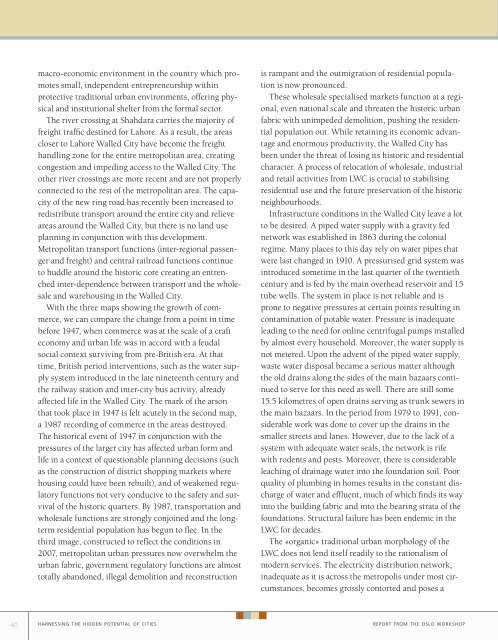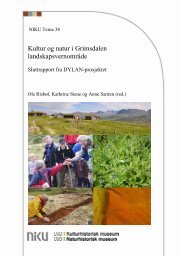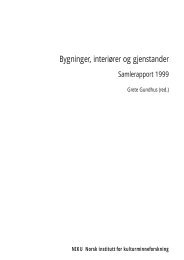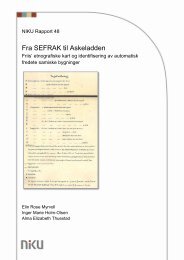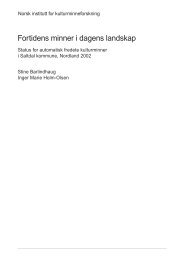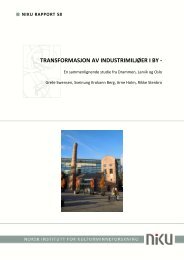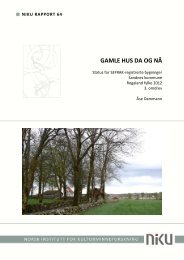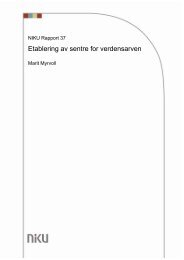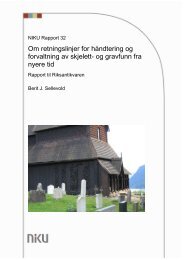Harnessing the hidden potential of cities - NIKU
Harnessing the hidden potential of cities - NIKU
Harnessing the hidden potential of cities - NIKU
You also want an ePaper? Increase the reach of your titles
YUMPU automatically turns print PDFs into web optimized ePapers that Google loves.
macro-economic environment in <strong>the</strong> country which promotes<br />
small, independent entrepreneurship within<br />
protective traditional urban environments, <strong>of</strong>fering physical<br />
and institutional shelter from <strong>the</strong> formal sector.<br />
The river crossing at Shahdara carries <strong>the</strong> majority <strong>of</strong><br />
freight traffic destined for Lahore. As a result, <strong>the</strong> areas<br />
closer to Lahore Walled City have become <strong>the</strong> freight<br />
handling zone for <strong>the</strong> entire metropolitan area, creating<br />
congestion and impeding access to <strong>the</strong> Walled City. The<br />
o<strong>the</strong>r river crossings are more recent and are not properly<br />
connected to <strong>the</strong> rest <strong>of</strong> <strong>the</strong> metropolitan area. The capacity<br />
<strong>of</strong> <strong>the</strong> new ring road has recently been increased to<br />
redistribute transport around <strong>the</strong> entire city and relieve<br />
areas around <strong>the</strong> Walled City, but <strong>the</strong>re is no land use<br />
planning in conjunction with this development.<br />
Metropolitan transport functions (inter-regional passenger<br />
and freight) and central railroad functions continue<br />
to huddle around <strong>the</strong> historic core creating an entrenched<br />
inter-dependence between transport and <strong>the</strong> wholesale<br />
and warehousing in <strong>the</strong> Walled City.<br />
With <strong>the</strong> three maps showing <strong>the</strong> growth <strong>of</strong> commerce,<br />
we can compare <strong>the</strong> change from a point in time<br />
before 1947, when commerce was at <strong>the</strong> scale <strong>of</strong> a craft<br />
economy and urban life was in accord with a feudal<br />
social context surviving from pre-British era. At that<br />
time, British period interventions, such as <strong>the</strong> water supply<br />
system introduced in <strong>the</strong> late nineteenth century and<br />
<strong>the</strong> railway station and inter-city bus activity, already<br />
affected life in <strong>the</strong> Walled City. The mark <strong>of</strong> <strong>the</strong> arson<br />
that took place in 1947 is felt acutely in <strong>the</strong> second map,<br />
a 1987 recording <strong>of</strong> commerce in <strong>the</strong> areas destroyed.<br />
The historical event <strong>of</strong> 1947 in conjunction with <strong>the</strong><br />
pressures <strong>of</strong> <strong>the</strong> larger city has affected urban form and<br />
life in a context <strong>of</strong> questionable planning decisions (such<br />
as <strong>the</strong> construction <strong>of</strong> district shopping markets where<br />
housing could have been rebuilt), and <strong>of</strong> weakened regulatory<br />
functions not very conducive to <strong>the</strong> safety and survival<br />
<strong>of</strong> <strong>the</strong> historic quarters. By 1987, transportation and<br />
wholesale functions are strongly conjoined and <strong>the</strong> longterm<br />
residential population has begun to flee. In <strong>the</strong><br />
third image, constructed to reflect <strong>the</strong> conditions in<br />
2007, metropolitan urban pressures now overwhelm <strong>the</strong><br />
urban fabric, government regulatory functions are almost<br />
totally abandoned, illegal demolition and reconstruction<br />
is rampant and <strong>the</strong> outmigration <strong>of</strong> residential population<br />
is now pronounced.<br />
These wholesale specialised markets function at a regional,<br />
even national scale and threaten <strong>the</strong> historic urban<br />
fabric with unimpeded demolition, pushing <strong>the</strong> residential<br />
population out. While retaining its economic advantage<br />
and enormous productivity, <strong>the</strong> Walled City has<br />
been under <strong>the</strong> threat <strong>of</strong> losing its historic and residential<br />
character. A process <strong>of</strong> relocation <strong>of</strong> wholesale, industrial<br />
and retail activities from LWC is crucial to stabilising<br />
residential use and <strong>the</strong> future preservation <strong>of</strong> <strong>the</strong> historic<br />
neighbourhoods.<br />
Infrastructure conditions in <strong>the</strong> Walled City leave a lot<br />
to be desired. A piped water supply with a gravity fed<br />
network was established in 1863 during <strong>the</strong> colonial<br />
regime. Many places to this day rely on water pipes that<br />
were last changed in 1910. A pressurised grid system was<br />
introduced sometime in <strong>the</strong> last quarter <strong>of</strong> <strong>the</strong> twentieth<br />
century and is fed by <strong>the</strong> main overhead reservoir and 15<br />
tube wells. The system in place is not reliable and is<br />
prone to negative pressures at certain points resulting in<br />
contamination <strong>of</strong> potable water. Pressure is inadequate<br />
leading to <strong>the</strong> need for online centrifugal pumps installed<br />
by almost every household. Moreover, <strong>the</strong> water supply is<br />
not metered. Upon <strong>the</strong> advent <strong>of</strong> <strong>the</strong> piped water supply,<br />
waste water disposal became a serious matter although<br />
<strong>the</strong> old drains along <strong>the</strong> sides <strong>of</strong> <strong>the</strong> main bazaars continued<br />
to serve for this need as well. There are still some<br />
15.5 kilometres <strong>of</strong> open drains serving as trunk sewers in<br />
<strong>the</strong> main bazaars. In <strong>the</strong> period from 1979 to 1991, considerable<br />
work was done to cover up <strong>the</strong> drains in <strong>the</strong><br />
smaller streets and lanes. However, due to <strong>the</strong> lack <strong>of</strong> a<br />
system with adequate water seals, <strong>the</strong> network is rife<br />
with rodents and pests. Moreover, <strong>the</strong>re is considerable<br />
leaching <strong>of</strong> drainage water into <strong>the</strong> foundation soil. Poor<br />
quality <strong>of</strong> plumbing in homes results in <strong>the</strong> constant discharge<br />
<strong>of</strong> water and effluent, much <strong>of</strong> which finds its way<br />
into <strong>the</strong> building fabric and into <strong>the</strong> bearing strata <strong>of</strong> <strong>the</strong><br />
foundations. Structural failure has been endemic in <strong>the</strong><br />
LWC for decades.<br />
The «organic» traditional urban morphology <strong>of</strong> <strong>the</strong><br />
LWC does not lend itself readily to <strong>the</strong> rationalism <strong>of</strong><br />
modern services. The electricity distribution network,<br />
inadequate as it is across <strong>the</strong> metropolis under most circumstances,<br />
becomes grossly contorted and poses a<br />
40 harnessing <strong>the</strong> <strong>hidden</strong> <strong>potential</strong> <strong>of</strong> <strong>cities</strong> report from <strong>the</strong> oslo workshop


